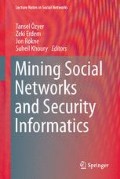Abstract
While criminals may start their activities at individual level, the same is in general not true for terrorists who are mostly organized in well established networks. The effectiveness of a terror network could be realized by watching many factors, including the volume of activities accomplished by its members, the capabilities of its members to hide, and the ability of the network to grow and to maintain its influence even after the loss of some members, even leaders. Social network analysis, data mining and machine learning techniques could play important role in measuring the effectiveness of a network in general and in particular a terror network in support of the work presented in this chapter. We present a framework that employs clustering, frequent pattern mining and some social network analysis measures to determine the effectiveness of a network. The clustering and frequent pattern mining techniques start with the adjacency matrix of the network. For clustering, we utilize entries in the table by considering each row as an object and each column as a feature. Thus features of a network member are his/her direct neighbors. We maintain the weight of links in case of weighted network links. For frequent pattern mining, we consider each row of the adjacency matrix as a transaction and each column as an item. Further, we map entries into a 0/1 scale such that every entry whose value is greater than zero is assigned the value one; entries keep the value zero otherwise. This way we can apply frequent pattern mining algorithms to determine the most influential members in a network as well as the effect of removing some members or even links between members of a network. We also investigate the effect of adding some links between members. The target is to study how the various members in the network change role as the network evolves. This is measured by applying some social network analysis measures on the network at each stage during the development. We report some interesting results related to two benchmark networks: the first is 9/11 and the second is Madrid bombing.
Access this chapter
Tax calculation will be finalised at checkout
Purchases are for personal use only
References
Agarwal R, Imielinski T, Swami A (1993) Mining association rules between sets of items in large databases. In: ACM SIGMOD international conference on management of data
Carley KM (2003) Dynamic network analysis. In: Breiger R, Carely KM (eds) The summary of the NRC workshop on social network modeling and analysis. National research council
Carley KM, Reminga J, Kamneva N (2003) Destabilizing terrorist networks. In: NAACSOS conference proceedings, Pittsburgh, PA
Carrington PJ, Scott J, Wasserman S (2005) Models and methods in social network analysis. Cambridge University Press, Cambridge
Farely DJ (2003) Breaking Al Qaeda cells: a mathematical analysis of counterterrorism operations. Stud Confl Terror 26:399–411
Freeman LC (1977) A set of measures of centrality based on betweenness. Sociometry 40:35–41
Freeman LC (1980) The gatekeeper, pair-dependency and structural centrality. Qual Quant 14(4):585–592
Freeman LC, White DR, Romney AK (1992) Research methods in social network analysis. Transaction Publishers, New Brunswick
Han J, Pei J, Yin Y (2000) Mining Frequent patterns without candidate generation. In: ACM SIGMOD international conference on management of data
Herrera F, Lozano M, Verdegay JL (1998) Tackling real-coded genetic algorithms: operators and tools for behavioural analysis. Artif Intell Rev 12(4):265–319
Jialun Q, Xu JJ, Daning H, Sageman M, Chen H (2005) Analyzing terrorist networks: a case study of the global Salafi Jihad network. In: Proceedings of IEEE international conference on intelligence and security informatics, Atlanta GA, pp 287–304
Kaya M, Alhajj R (2008) Multi-objective genetic algorithms based automated clustering for fuzzy association rules mining. J Intell Inf Syst 31(3):243–264
Kleinberg JM (1998) Authoritative sources in a hyperlinked environment. In: Proceedings of the ninth annual ACM-SIAM symposium on discrete algorithms, pp 668–677
Klerks P (2001) The network paradigm applied to criminal organizations. Connections 24(3)
Knoke D, Yang S (2008) Social network analysis, series: quantitative applications in social sciences. Sage, Thousand Oaks
Krebs V (2002) Mapping networks of terrorist cells. Connections 24(3):43–52
Michalewicz Z (1992) Genetic algorithms + data structures = evolution programs. Springer, Berlin
Özyer T, Alhajj R (2006) Achieving natural clustering by validating results of iterative evolutionary clustering approach. In: Proc. of IEEE international conference on intelligent systems, pp 488–493
Peng P Nagi M et al. (2011) From alternative clustering to robust clustering and its application to gene expression data. In: Proc. of IDEAL, LNCS. Springer, Norwich
Puzis R, Elovici Y, Dolev S (2007) Finding the most prominent group in complex networks. AI Commun 20(4):287–296. 2007
Scott J (1998) Trend report: social network analysis. Sociology 109–127
Shaikh MA, Wang J (2006) Discovering hierarchical structure in terrorist networks. In: Proceedings of the international conference on emerging technologies, pp 238–244
Sparrow MK (1991) The application of network analysis to criminal intelligence: an assessment of the prospects. Soc Netw 13(3):251–274
Strogatz SH (2002) Exploring complex networks. Nature 410:268–276
Tsvetovat M, Carley KM (2005) Structural knowledge and success of anti-terrorist activity: the downside of structural equivalence. J Soc Struct 6(2)
Wasserman S, Faust K (1994) Social network analysis: methods and applications. Cambridge University Press, Cambridge
Xu J, Chen H (2005) CrimeNet explorer: a framework for criminal network knowledge discovery. ACM Trans Inf Syst 23(2):201–226
Author information
Authors and Affiliations
Corresponding author
Editor information
Editors and Affiliations
Rights and permissions
Copyright information
© 2013 Springer Science+Business Media Dordrecht
About this chapter
Cite this chapter
Elhajj, A. et al. (2013). Estimating the Importance of Terrorists in a Terror Network. In: Özyer, T., Erdem, Z., Rokne, J., Khoury, S. (eds) Mining Social Networks and Security Informatics. Lecture Notes in Social Networks. Springer, Dordrecht. https://doi.org/10.1007/978-94-007-6359-3_14
Download citation
DOI: https://doi.org/10.1007/978-94-007-6359-3_14
Publisher Name: Springer, Dordrecht
Print ISBN: 978-94-007-6358-6
Online ISBN: 978-94-007-6359-3
eBook Packages: Computer ScienceComputer Science (R0)

